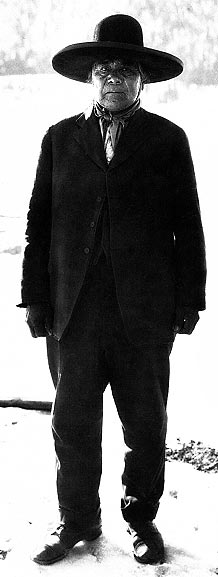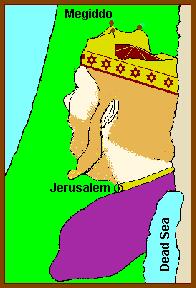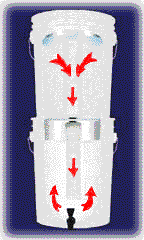
The Dead Sea Scrolls Controversy
|
The Dead Sea Scrolls Controversy
by Steve Mizrach
The current furor over the Dead Sea Scrolls has mostly been examined by the
media as a simple scholarly feud. It is scandal enough that scroll researchers
have restricted access by "outsiders" to the scrolls for over forty years.
(The history and politics of the scrolls' acquisition is long, complex, and
well known, and I will not go into it here.) But if it were merely yet another
academic "turf" war or simple scholarly egoism, the controversy would not
merit as much attention.
The problem is that the scrolls deal with very pertinent matters surrounding
the development of modern Christianity and Judaism. The position that the
scroll researchers have tried to bulwark for forty years is that the Essenes
of Qumran were external to "normative" Judaism or Christianity, a fringe
sect with little connection to events of the time. (Recently, the theory
has been raised that the Qumranites may have been Sadducees instead, as the
word "Essene" does not appear anywhere in the documents. This theory has
been summarily dismissed, but the difference may have been nothing more than
semantic, as we shall see.)
Based on Josephus' accounts, a popular image of the Essenes has been that
they were pacifist, ascetic, celibate, separatist, and apolitical mystics.
This image is at least partially true: but Josephus contradicts himself at
various points. He adds, almost as an afterthought, the observation that
some of the Essenes were married, participated in Zealot revolutionary
activities, and lived within the city of Jerusalem. It is also curious that
the speech at Masada delivered by the surviving Zealot commander seems remarkably
Essene in orientation, at least as recorded by Josephus. Archaeological evidence
found at Qumran points out some interesting facts: a forge for weapons was
found, as well as many Roman and non-Roman arrowheads, and evidence of
fortifications. This suggests that Qumran may have been more of a fortress
than a monastery. It is curious as to why the Romans appear to have driven
out these harmless mystics somewhere around AD 68, right in the middle of
the Jewish Revolt. Also found at Qumran were graves for women and children;
and coins minted in Jerusalem as well as artifacts produced there. Family
life and commercial integration appear to have been very "mainstream" for
the Qumran community.
But the internal evidence of the scrolls does not make the Essenes "ordinary
joes." The so-called Temple Scroll suggests that they had a dream
of rebuilding a new Temple of visionary dimensions after razing Herod's to
the ground. The Copper Scroll suggests they had knowledge of the
whereabouts of many Temple treasures and connections to some elements of
the priesthood, although they had fierce opposition to the wealthy, elite,
pro-Roman, Hellenizing Sadducean Temple establishment. They had a very particular
Messianic expectation of the arrival of two "twin Messiahs": the "Aaronic
Messiah" would be the legitimate anointed high priest and he would herald
the "Davidic Messiah" who would restore the true sacred kingship. The War
Scroll suggests that they had a vision of a cosmic conflict between the forces
of light and darkness: the Gentile "kittim" or Romans against the "sons of
light," namely, the Essenes. Other scrolls interpret biblical prophecies
to describe current political events, offer strange apocalyptic and
eschatological predictions, and incorporate some of the "pseudepigraphal"
and "apocryphal" material of the Intertestamental Period. And the
"Damascus" Document suggests that their leader, the Teacher
of Righteousness, was persecuted by an illegitimate member of the priesthood
they called the Wicked Priest, and put to death.
The scholarly team controlling the scrolls has kept a lid on the explosive
contents of the Damascus Document by an interesting trick. Using poor
philological and graphological analysis, they date that scroll to the 2nd
century BCE -- hence it becomes a missive against one of the Maccabean kings,
who illegitimately assumed the kingship and priesthood and became Hellenizers
toward the end of their reign. But it also could be as much an indictment
of Herodian rule as Maccabean... and there are some indications that it may
be a 1st century CE document instead. As to the name of the document, it
is a curiosity -- there were no Essenes that lived in Damascus in Syria --
unless one realizes that "Damascus," as described geographically by the scroll,
can be nowhere else but on the Dead Sea. The objectivity of the scroll
researchers on these controversial questions is itself questionable, as de
Vaux and many others are members of the Ecole Biblique, an institution
formed to combat Modernist tendencies in Catholicism and promote pro-Catholic
readings of scripture. The one agnostic on the team, John Allegro, tried
to release early reports of scroll contents, and was subsequently hounded
off the team in the 1970s. (Though, one might note, he later responded by
asserting authoritatively that Jesus may have been a mushroom, based on some
speculative translations of various Aramaic words.)
What are the scroll researchers really afraid of? Robert Eisenman, an independent
scholar, notes that more may be at stake than just academic defensiveness.
Eisenman notes that many of the names used by the Essenes to refer to themselves
-- Zadokim (the Just), Ebionim (the Poor), Nazoreans
(the Pure), Hasideans (Zealous for the law), etc. -- are also some
of the appellations used by the entity known as the "early Church" or
"Jewish-Christians" or "Jerusalem Church." Eisenman believes that the Zealots,
Essenes, Nazoreans, etc. were all just names for one single movement with
different aspects, but very specific goals: restoration of the legitimate
anointed (Meshiach) king and high priest, expulsion of the Roman
occupation and the pro-Roman Herodians and Sadducees, and religious
reconstruction. Jesus, then, may have been a legitimate dynast (his genealogy
from the line of David is given in two of the Synoptic Gospels), and a real
political threat to the Romans , not the religious authorities of the Sanhedrin.
After his death, Eisenman notes, Jesus' followers coalesced behind his brother
James the Just, who may well have been the Essene Teacher of Righteousness;
he was put to death by the pro-Roman high priest Phinehas, who is an excellent
candidate for the Wicked Priest.
A bold hypothesis, you might ask. If early Christianity was really a
revolutionary political movement fully within the sphere of Judaism at the
time... whence the Christianity of today? That story can be traced to a certain
Saul of Tarsus. This tentmaker, who apparently had very influential friends
among the Sadducees, was sent to "Damascus" to root out "Christians" there.
Of course, he would have had no authority to carry out those orders in a
different part of the Empire than Palestine. But if "Damascus" is "Qumran"
a new picture begins to emerge... along the way Saul has a "conversion" and
becomes Paul, a "Christian." Shortly after this experience, as recorded in
the Acts of the New Testament, the very vigorous Paul travels all over the
Roman Empire and preaches Christ. Except... James and members of the Jerusalem
"Church" complain he is preaching "another Christ," telling people to be
"apostates from the law," and promoting "deviation."
Imagine this scenario: James and his followers attempt a Messianic crusade
focusing on returning the "lost sheep" of Israel to the fold. (The key to
successful revolt would be the enlistment of Jews all over the Empire --
many Jews lived in Persia, Babylonia, and Egypt at the time.) Along comes
this Paul, who claims he wants to assist them in their efforts for revolutionary
recruitment. Only... he seems to be preaching a new religion which is distinct
from, and even inherently opposed to Judaism: proclaiming that a very holy
but earthly man was also divine, recruiting among the Gentiles using pagan
concepts (the dying-and-resurrected god and virgin birth are features of
the Mithras and Attis cults), and betraying Jewish nationalist aspirations
by focusing on a very otherworldly "kingdom of heaven" rather than a concrete
political restoration.
So who was Paul? Eisenman suggests he may have been an agent provocateur
. He may have even been the individual that the Damascus Document identifies
as "the Liar" and "the Apostate." And as to why he went to the effort to
found a new religion, Eisenman suggests that it was a brilliantly conceived
means to defuse the very this-world, political significance of Jesus and
his Davidic bloodline. As an agent of the pro-Roman Sadducee establishment,
he found a perfect way to deflect anti-Roman agitation into yet another Roman
mystery cult. He apparently succeeded very well. When Bar Kochba revolted
yet again against the Romans in 132 CE, he turned to the "Christians" for
help, and became extremely angry when they declared opposition to his goals.
The Roman authorities still remained concerned about potential threats: Eusebius
records that the Emperor went to special efforts to assure that members of
Jesus' family, the so-called Desposyni -- in the 2nd century CE! --
remained loyal to the Empire and were not planning rebellion. The Romans
may have had more reasons to throw "Christians" to the lions than merely
worrying that the moralistic folk might cancel their orgies and parties,
especially if early Christianity were an anti-Roman political movement.
In a sense, Constantine completes our story. His efforts to make "Roman"
Christianity the religion of the Empire (which suggests that the "bishops"
of cities such as Antioch, Alexandria, and Jerusalem may have had another
"brand") and to impose uniformity through the Council of Nicaea essentially
cut off the stream of "Nazorean Christianity" from history. The New Testament
has clearly been altered (if the accounts of Mark, etc. thirty years after
the fact are even accurate) to provide a pro-Roman bias. The Sanhedrin, rather
than Roman authorities, are blamed for Jesus' death, as are the "Jews" in
some vague way. There are clearly Zealots in Jesus' entourage and John the
Baptist appears to be an Essene; some of Jesus' sayings are borrowed from
prominent Pharisees such as Hillel. Yet the New Testament seems to condemn
all these groups. Incidents suggesting violent resistance, revolutionary
activity, dynastic marriage, and political alliance seem to be hinted at
but quietly hushed up. And everywhere attention to Rome and the real situation
in Palestine are deflected to otherworldly concerns; Jesus is transformed
into some kind of divine figure, though he himself repudiates those who believe
such a thing. The New Testament seems to be a sort of fairy tale situated
in a very bloody, turbulent time.
Moses Hess wrote an important book in the 19th century entitled Rome and
Jerusalem . He examined the twin roots of modern Western civilization,
Hebraic and Hellenistic, monotheistic and pagan, and examined their opposition.
It was clear that, for a while, the two poles struggled mightily against
one another. The result was a victory of one and then a curious fusion of
the two ... and through "Christendom" and the rule of the Catholic Church
the West was nurtured on this admixture. Rome won that conflict, perhaps
through historical accident as much as anything else. The West is a curious
blend of Roman values -- hierarchy, martial rule, imperialism, bread and
circuses -- and the Hebraic prophetic tradition of justice, law, and equality.
Nietzche knew that and so have others. One might reflect on our
"Judaeo-Christian" tradition in light of that.
Further Resources
[Click on the titles to read reviews and to order online if you'd like. You'll
buy them at a discount. Enjoy!]
The
Complete Dead Sea Scrolls in English
by Geza Vermes (Editor)
The
Dead Sea Scrolls: A New Translation
by Michael Wise, Martin Abegg, Edward Cook
The
Dead Sea Scrolls: The Untold Story
by Kenneth Hanson
The
Dead Sea Scrolls and the Christian Myth
by John M. Allegro
The
Dead Sea Scrolls Bible: The Oldest Known Bible
edited by Martin Abegg et al
The
Dead Sea Scrolls Deception
by Michael Baigent and Richard Leigh
The
Gnostic Gospels
by Elaine Pagels
The
Gospel of Thomas: The Hidden Sayings of Jesus
by Marvin Meyer (Translator)
Dead
Sea Scrolls: The Complete Story
by Jonathan Campbell
The
Lost Gospel: The Book of Q and Christian Origins
by Burton L. Mack
James
the Brother of Jesus: The Key to Unlocking the
Secrets of Early Christianity and the Dead Sea Scrolls
by Robert Eisenman
The
Jesus Legend
by George Albert Wells
The
Nag Hammadi Library in English
by James M. Robinson
The
Riddle of the Dead Sea Scrolls
Discovery Channel (Book)
The
Riddle of the Dead Sea Scrolls
Discovery Channel (Video)
Voices
from the Dead Sea Scrolls
Video
Who
Wrote the New Testament?
The Making of the Christian Myth
by Burton L. Mack

|

























